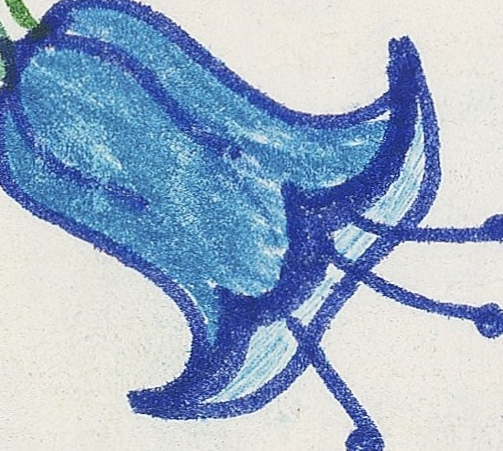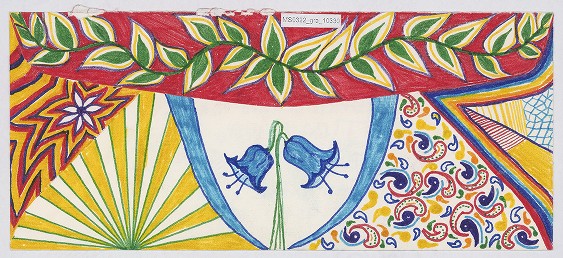The Grateful Dead Archive Online threw open its virtual doors in late June, 2012. This project has gotten a lot of attention from both the archives community and the Grateful Dead community. I got a message from my husband shortly after it went online directing me to the envelope shown above from the fan art section of the site. This was the envelope I helped decorate for our mail order ticket request sent back in January of 1992. The theory was that if you made your envelope beautiful, it was more likely to get pulled out of the pile of orders vying for a limited number of tickets. It worked for us this time – we plan to upload images of the tickets we received from that order (yes, we still have them!).
A little digging shows that the site is built on the open source Omeka platform. The prominent milestones timeline was built using the Neatline suite of Omeka plugins. The Omeka platform gives the site creator a lot of flexibility in what data is used to manage the collection.
The amount of metadata that the GDAO staff have populated on their 45,000 digitized items is quite impressive. They have tied the materials into the logical structure dictated by the Grateful Dead’s concerts. You can search for items related to a specific venue or a specific show by zooming in to locations on a map of the world to pick out individual venues where the Dead played. A wealth of media from the Internet Archive is tied into the site so that it is easy to find using the standard search mechanisms and cross linking based on metadata. The artists section features both photographers and poster artists. Two exhibits are in place for the site launch – one on Europe ’72 and the other on the Posters of the Grateful Dead Archive.
The resolution of the scanned fan art is amazing. Take a look at how far I could zoom in to the bluebell I drew way back when. I wonder what their default scanning resolution was?

The site also invites the Grateful Dead community to contribute items to the collection. They have a wish list for content to flesh out gaps they see in what they have.
These are the types available for selection when contributing content:
- Audio
- Image
- Video
- Your Story
- Poster
- Ticket
- Laminate
- Backstage Pass
- Article
For each of the contributions, the user is asked for a mandatory Title, and optional Description, Date of Show, Venue Name and Venue Location. The contribution page also prompts the user to enter their name, e-mail, copyright and license.
For license, the user is given three options and encouraged to select one of the broader Creative Commons licenses rather than the more restrictive default license only granting rights to the University of California.
- I am contributing this work and irrevocably grant a non-exclusive, perpetual, royalty-free, worldwide license for this work to the University of California Regents to display, distribute, reproduce, perform, or create derivatives works based upon it.
- I am contributing this item under a Creative Commons Attribution (CC BY) License. Others are free to share, remix, or make commercial use of the work as long as they credit me.
- I am contributing this item under a Creative Commons Attribution-NonCommercial (CC BY_NC) License. Others are free to share or remix the work noncommercially, as long as they credit me.
For the ‘Your Story’ option, the user is also prompted with the following:
- How did you become a Deadhead?
- What is your favorite Dead show, and why?
- What is your favorite Dead song, and why?
- What is your favorite aspect of the Dead scene?
- What, if anything, do you think is important about the Dead, and about the Dead phenomenon?
I really loved that they provide a phone number which you can call and leave up to a three minute message which they will then transcribe for you. This looks to be an example (the first according to the comment) of a ‘Your Story’ submission.
The Advanced Search page gives us a full list of formats:
- Album Cover
- Article
- Backstage Pass
- Envelope
- Fan Art
- Fan Tape
- Fanzine
- Image
- Laminate
- Newsletter
- Notebook
- Poster
- Program
- Story
- T-Shirt
- Ticket
- Sound
- Video
- Website
The search results let you filter by item type, creator name, venue, year and subject. I wish I could see a full list of the subjects. They seem to be a mix of named individuals associated with the band, events and song titles.
The Grateful Dead Archive Online is a great example of what can be done with good planning and the staff necessary to follow through with the vision. I appreciated the thought that clearly went into the copyright and license issues – both for content being contributed as well as content owned by the archive. I also see evidence of efforts to build a sense of community. The ‘Your Story’ contribution form specifically mentions that contributors should consider carefully what they share and how it might reflect on others. Each item offers the option to post comments as well as to add tags. It will be interesting to how these communal aspects of the site grow over time. Many archives have to work to build community – but the Grateful Dead fan community has a long and strong history.
Finally – as I mentioned above, the item level description is impressive. I was amazed to note that the envelope shown above was linked to the two shows the request was for, the creation date was tied to the post mark, the extent was the envelope’s measurements and the citation included the name of the creator from the return address. And yes – we know that they misspelled Smyth as Smith. We have already let them know about the typo and received a prompt response with a promise to fix the spelling.

Pingback:it must have been the roses « alive in the sea of information
I have a 8 x 10 print on photo paper from the original negitive used on the album Mars Hotel. Where can I get this appraised for value?
Great question James. I honestly don’t know. Perhaps you can contact the Grateful Dead Archive Online directly at grateful@ucsc.edu. They might know of a resource for this type of appraisal. Good luck!